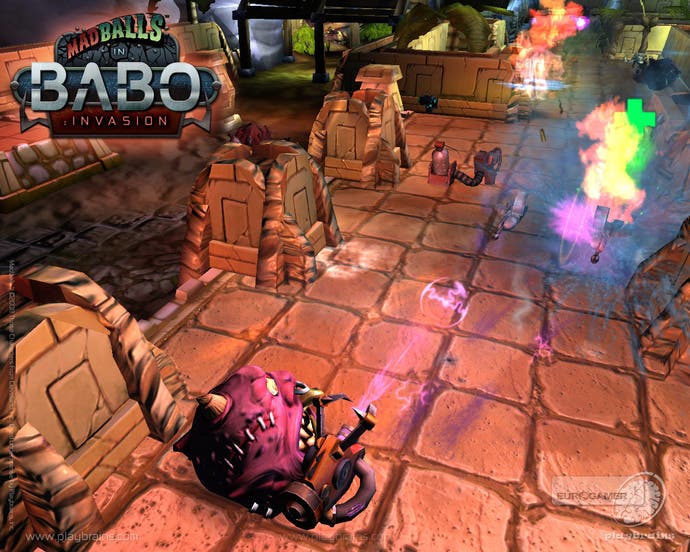Madballs in Babo: Invasion
Nothing to sphere.
At checkpoints it's possible to change into a different Madball form, each one with its own unique ability. These might enable you to temporarily ping around an environment like an enraged pinball, or pop to twice your normal size in order to crush enemies. However as the designers grant you the choice of which form to take at any one point, almost none of the puzzles or challenges require the use of a specific ability, neutering this tool's importance.
Enemy balls have elemental properties, so choosing the right weapon is key to securing quick takedowns. Checkpoints usually contain one or two new weapons to choose between, but you'll need to learn the levels before you know which will best match the coming enemies. Targeting enemies on ledges can also be irksome as the game's reticule adjusts its targeted plane on-the-fly, leading to some frustrating moments where you attempt to fend off multiple attackers at various heights.
Considering it's 800 MSP Madballs is packed with content; the single-player campaign's relative brevity is counterbalanced by a raft of multiplayer modes. Avatar Attack is a cute and enjoyable diversion, taking your Xbox 360 avatar's head and tooling it up with rocket launchers, flamethrowers and shuriken guns in a Deathmatch mode. As you shoot down your rivals, so your head grows in size, earning a health boost at the cost of a speed downgrade with every growth spurt.
While some XBLA games rely too heavily on the mere novelty of adding avatars, here the underlying game is solid and enjoyable. The personalisation adds to the concept rather than attempting to redeem it.
A second innovative multiplayer mode, Invasion, allows two teams to place environment tiles one by one in order to design the level corporately, before fighting across it to secure their opponent's base. It's a good idea well-executed and provides welcome distraction from the other stock Deathmatch and team skirmish modes.

In single-player mode the game seems unsure of its identity. Half the game systems are geared towards serious score attack play, with multipliers for thorough enemy takedowns that must be balanced with rewards for speed and efficiency. But this focus is thrown off by the game's laboured puzzles. The endless parade of switches that must be thrown and passages that must be navigated becomes tiresome and repetitive.
This ensures that the game's top scorers will be those who learn the level layouts, taking a speed-run approach to mastery. Conversely, those players who prefer to rely on shmup-style reaction and fortune over planning and revision will be at a disadvantage.
In the multiplayer modes, the incentives towards teamwork and planning built into the creative game modes are, in practice, discarded for an everyman-for-himself approach. The simplicity of the core game mechanics combined with the speed and precise control of the ball avatars scuppers the need for real long-view tactics and planning.
The result is Benny Hill-style combat as gun-toting balls race around at high-speed, taking random pot-shots at one another. There's no denying this has its appeal, but the fun's short-lived. There's just not enough depth and nuance here to sustain prolonged play.
